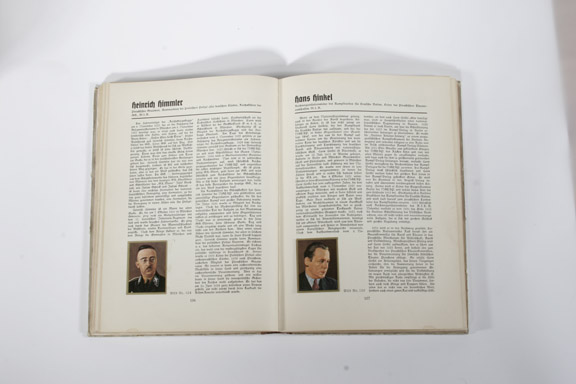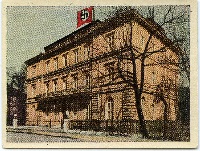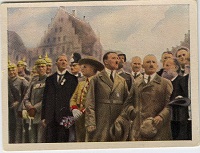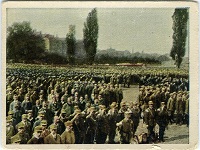Propaganda from the Early Nazi Regime

“Through these individual destinies the complete national destiny will be told...
The purpose of this book is to help the German youth...become familiar with the story
of their leaders and with the history and development of the Third Reich.”
- A quote from the album’s introduction, translated from the German
The book Men in the Third Reich (Männer im Dritten Reich), was published by the Oriental
Cigarette Company "Rosma" in Bremen, Germany in the summer of 1934.
This book was brought to Seattle in 1945 by Charles E. Harris, who served in the United States Army during World War II. His daughter, Susan Harris, donated the book to the Holocaust Center for Humanity.
In March 1943, at the age of 19, Charles E. Harris was called to active duty in the United States Army. For the next 33 months, he fought in both France and Germany. Charles was discharged in September 1945 and moved to Seattle, where he lived until his death in 1998. Charles obtained Men in the Third Reich* while in Germany, but he never told his family specifically where or how he got the book.
This book is a cigarette card album. The pictures of Nazi leaders (as seen on the open pages of the book) were originally not attached to the book, but were found in cigarette boxes.
A person could purchase or order an album in which to collect these cigarette cards. Each page in this book has a biography of one of the Nazi leaders and a place to glue the appropriate card.
In the early 1930's collectable cards in cigarette packs were an exciting new form of media
The potential to use these cards and albums to promote political ideas was quickly realized by the Nazi party. Collecting cigarette cards became especially popular with young people.
Today we identify this book as Nazi propaganda. Propaganda is defined in the Merriam-Webster dictionary as "the spreading of ideas, information, or rumor for the purpose of helping or injuring an institution, a cause, or a person."
The Nazi Party was a political party in Germany from 1920 to 1945. In Germany's 1932 election the Nazi party received more support than any of the other parties. In 1933, Adolf Hitler, the party's leader, was appointed Chancellor of Germany. Only one year later, in 1934, this book was published.
Men in the Third Reich portrays each Nazi party member as a model leader, a hero.
Heinrich Himmler, the leader of the German SS** and instrumental in overseeing the "Final Solution" (the Nazi plan for the mass murder of the Jewish people) is described in the album as follows:
"[Heinrich Himmler], along with others, arranged the well-known Concentration-Camp Dachau, which is indeed one of the model camps for political inmates in Germany... he has never shrunk from responsibility, and today, because of him, we know the domestic safety of the Reich is in good hands."
- Quote from Heinrich Himmler's biography in Men in the Third Reich. Translated from the German.
* Third Reich - The Third Regime or Empire. The official name of Hitler's regime which ruled from 1933-1945. Historically, the First Reich was the medieval Holy Roman Empire, which lasted until 1806. The Second Reich included the German Empire from 1871-1918.
**German SS – Schutzstaffel. An elite Nazi force. The SS controlled the German police and the concentration camp system. Among other things, the SS was responsible for security, identification, and population policy. The SS was known to be excessive in their force and brutality.
Cigarette Cards




Taking advantage of the popularity of smoking in Germany, the Nazi party included propaganda on hundreds of small cards in packets of cigarettes for citizens to collect. Martin Metzon's family owned a tobacco and wine shop in Copenhagen, allowing him to compile a complete collection of the available cards which he recovered from his home after fighting with the Danish Resistance during the war. Pictured here:
1. The Burning of the Reichstag
2. The Braune Haus, Nazi party headquarters in Munich
3. Adolf Hitler and Julius Streicher in Nürnberg, 1923
4. The first German Day in Nürnberg, 1923
Additional Resources
State of Deception: The Power of Nazi Propaganda (USHMM Exhibit)
The Cigarette Cards--More Details
